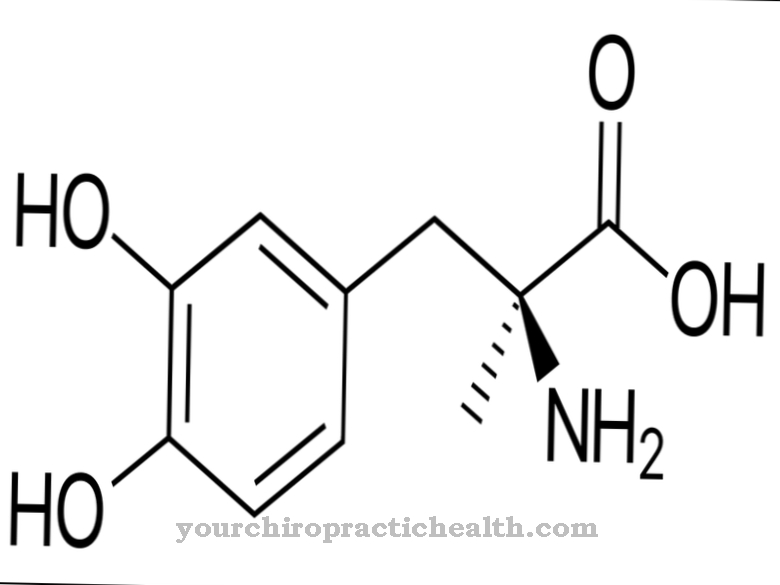At Clonazepam it is an anticonvulsant that comes from the group of benzodiazepines. It is used to treat mental illness and epilepsy.
What is clonazepam?

Clonazepam is one of the drugs that have both calming and antispasmodic properties. It belongs to the group of benzodiazepines. The remedy promotes sleep and has a positive effect against anxiety. However, it is mainly used to treat epileptic convulsions.
The first benzodiazepine, called chlordiazepoxide, came onto the market in 1960 by the pharmaceutical company Hoffmann-La Roche. In the years that followed, other benzodiazepines were developed that had different effects. From 1964 onwards, clonazepam was also patented, which was offered in the United States of America from 1975.
Pharmacological effect
As a benzodiazepine, clonazepam has the property of binding to certain receptors in the brain that are specific for this group of substances. The nerve cells in the brain communicate with the help of special messenger substances called neurotransmitters. At the contact point, a nerve cell releases neurotransmitters that either inhibit or stimulate. This in turn causes the inhibition or excitation of the downstream nerve cell, whose perception of the messenger substance occurs through the receptors, which are docking points. However, the nerve cell can only ever produce a certain type of messenger substance and then release it.
One of the most important inhibitory neurotransmitters is GABA (gamma-aminobutyric acid). By taking clonazepam, the inhibitory effects of GABA on various nerve nodes can be increased. As a result, clonazepam dampens brain excitability, which in turn can counteract the tendency to epileptic cramps. Through this procedure, clonazepam is well suited as an antispasmodic, sedative and sleep-inducing drug.
In contrast to barbiturates, the risk of respiratory depression is less pronounced with benzodiazepines such as clonazepam. On the other hand, however, there is a higher risk of benzodiazepine abuse because of the rapid adaptation to the clonazepam.
After taking the clonazepam, the active ingredient is released into the blood through the intestine. After one to four hours, the agent reaches its highest level in the body. Since clonazepam has a fat-soluble effect, it can primarily accumulate in the brain. The liver converts the benzodiazepine into degradation products that no longer have any effect. They get out of the body mainly through urine and stool.
Medical application & use
Clonazepam is mainly used to treat various forms of epilepsy. The product is also suitable for treating babies and children. The active ingredient is also used to treat movement disorders such as restless legs syndrome, unrest or cramps in the masticatory muscles, as well as anxiety, social phobias or sleepwalking.
However, the use of the agent must not last longer than a few weeks. Otherwise there is a risk of becoming dependent on clonazepam. In addition, the drug loses its effect after a while. However, permanent treatment with clonazepam is sometimes essential, for example if you have severe epilepsy that cannot be treated effectively by other means.
Clonazepam is usually given in the form of tablets. Up to an amount of 250 milligrams of clonazepam per tablet pack, the drug is available on prescription from pharmacies. At higher doses, the Narcotics Act applies, so a special narcotics prescription is required. It is recommended not to exceed a total daily dose of 8 milligrams.
Clonazepam drops are also available for patients with swallowing disorders and children under six years of age. Basically, treatment is started with a low dose of clonazepam. In the further course of the therapy there is a gradual increase.
Treatment with clonazepam must not be stopped abruptly, as this could result in seizures. For this reason, the dose is gradually reduced.
Risks & side effects
Therapy with clonazepam can result in side effects that can be compared with those of other benzodiazepines. These primarily include tiredness, increased reaction time, dizziness, decreased muscle tension, muscle weakness and unsteady gait. Reddening of the skin, itching, pigment changes, temporary hair loss, hives, urinary incontinence, stomach problems, nausea, headache, a lack of blood platelets and the loss of libido are also possible.
An allergic reaction or an allergic shock can rarely occur. Elderly patients must exercise particular caution because of the muscle-slacking effects, as there is an increased risk of falling.
There are also some contraindications. For example, clonazepam must not be administered if there is hypersensitivity to benzodiazepines or if there is a severe dysfunction of the breathing or liver, as well as drug or alcohol dependence. Because clonazepam can penetrate the placenta to the unborn child and accumulate in it, the active ingredient should not be administered during pregnancy. In the event of an overdose, mental disabilities or malformations are conceivable in the child. It should also not be used during breastfeeding, as the agent can get into breast milk. This threatens the child with breathing difficulties.
Interactions between clonazepam and other drugs that affect the brain are also possible. These can be sedatives, sleeping pills, anesthetics, pain relievers, psychotropic drugs or H1 antihistamines. These have an intensifying effect on the remedy. The same goes for the consumption of alcohol.















.jpg)







.jpg)




